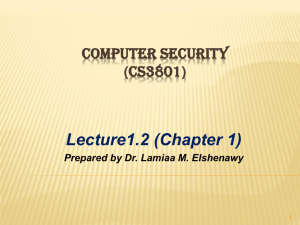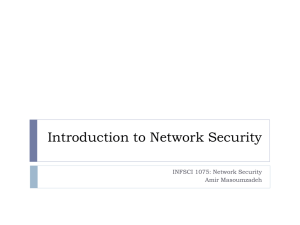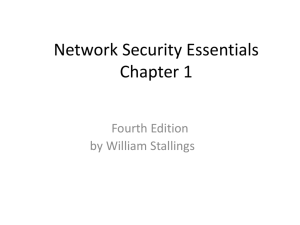Security Mechanism
advertisement
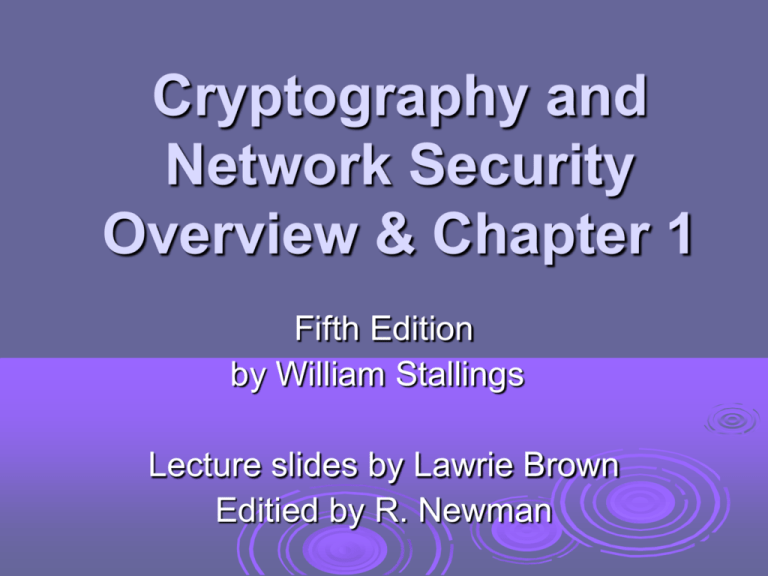
Cryptography and Network Security Overview & Chapter 1 Fifth Edition by William Stallings Lecture slides by Lawrie Brown Editied by R. Newman Chapter 0 – Reader’s Guide The art of war teaches us to rely not on the likelihood of the enemy's not coming, but on our own readiness to receive him; not on the chance of his not attacking, but rather on the fact that we have made our position unassailable. —The Art of War, Sun Tzu Roadmap Cryptographic algorithms symmetric ciphers asymmetric encryption hash functions Mutual Trust Network Security Computer Security Standards Organizations National Institute of Standards & Technology (NIST) Internet Society (ISOC) International Telecommunication Union Telecommunication Standardization Sector (ITU-T) International Organization for Standardization (ISO) RSA Labs (de facto) Chapter 1 – Introduction The combination of space, time, and strength that must be considered as the basic elements of this theory of defense makes this a fairly complicated matter. Consequently, it is not easy to find a fixed point of departure.. — On War, Carl Von Clausewitz Computer Security the protection afforded to an automated information system in order to attain the applicable objectives of preserving the integrity, availability and confidentiality of information system resources (includes hardware, software, firmware, information/data, and telecommunications) Key Security Concepts Levels of Impact can define 3 levels of impact from a security breach Low Moderate High Low Impact The loss could be expected to have a limited adverse effect on organizational operations, organizational assets, or individuals. A limited adverse effect means that, for example, the loss of confidentiality, integrity, or availability might (i) cause a degradation in mission capability to an extent and duration that the organization is able to perform its primary functions, but the effectiveness of the functions is noticeably reduced; (ii) result in minor damage to organizational assets; (iii) result in minor financial loss; or (iv) result in minor harm to individuals. Moderate Impact The loss could be expected to have a serious adverse effect on organizational operations, assets, or individuals. A serious adverse effect means that, e.g., the loss might (i) cause a significant degradation in mission capability to an extent and duration that the organization is able to perform its primary functions, but the effectiveness of the functions is significantly reduced; (ii) result in significant damage to organizational assets; (iii) result in significant financial loss; or (iv) result in significant harm to individuals that does not involve loss of life or serious, life-threatening injuries. High Impact The loss could be expected to have a severe or catastrophic adverse effect on organizational operations, organizational assets, or individuals. A severe or catastrophic adverse effect means that, for example, the loss might (i) cause a severe degradation in or loss of mission capability to an extent and duration that the organization is not able to perform one or more of its primary functions; (ii) result in major damage to organizational assets; (iii) result in major financial loss; or (iv) result in severe or catastrophic harm to individuals involving loss of life or serious life threatening injuries. Examples of Security Requirements – student grades integrity – patient information availability – authentication service authenticity – admission ticket non-repudiation – stock sell order confidentiality Computer Security Challenges 1. 2. 3. 4. 5. 6. 7. 8. 1. 2. not simple – easy to get it wrong must consider potential attacks procedures used counter-intuitive involve algorithms and secret info must decide where to deploy mechanisms battle of wits between attacker / admin not perceived to be of benefit until it fails requires regular monitoring a process, not an event too often an after-thought regarded as impediment to using system “Unusable security is not secure” OSI Security Architecture X.800 “Security Architecture for OSI” defines a systematic way of defining and providing security requirements for us it provides a useful, if abstract, overview of concepts we will study ITU-T Aspects of Security consider security attack security mechanism (control) security service note 3 aspects of information security: terms threat – a potential for violation of security vulnerability – a way by which loss can happen attack – an assault on system security, a deliberate attempt to evade security services Passive Attack - Interception Passive Attack: Traffic Analysis Observe traffic pattern Active Attack: Interruption Block delivery of message Active Attack: Fabrication Fabricate message Active Attack: Replay Active Attack: Modification Modify message Handling Attacks Passive attacks – focus on Prevention • Easy to stop • Hard to detect Active attacks – focus on Detection and Recovery • Hard to stop • Easy to detect Security Service enhance security of data processing systems and information transfers of an organization intended to counter security attacks using one or more security mechanisms often replicates functions normally associated with physical documents • which, for example, have signatures, dates; need protection from disclosure, tampering, or destruction; be notarized or witnessed; be recorded or licensed Security Services X.800: “a service provided by a protocol layer of communicating open systems, which ensures adequate security of the systems or of data transfers” RFC 2828: “a processing or communication service provided by a system to give a specific kind of protection to system resources” Security Services (X.800) Authentication - assurance that communicating entity is the one claimed have both peer-entity & data origin authentication Access Control - prevention of the unauthorized use of a resource Data Confidentiality –protection of data from unauthorized disclosure Data Integrity - assurance that data received is as sent by an authorized entity Non-Repudiation - protection against denial by one of the parties in a communication Availability – resource accessible/usable Security Mechanism a.k.a. control feature designed to detect, prevent, or recover from a security attack no single mechanism that will support all services required however one particular element underlies many of the security mechanisms in use: cryptographic techniques hence our focus on this topic Security Mechanisms (X.800) specific security mechanisms: encipherment, digital signatures, access controls, data integrity, authentication exchange, traffic padding, routing control, notarization pervasive security mechanisms: trusted functionality, security labels, event detection, security audit trails, security recovery Model for Network Security Model for Network Security using this model requires us to: 1. 2. 3. 4. design a suitable algorithm for the security transformation generate the secret information (keys) used by the algorithm develop methods to distribute and share the secret information specify a protocol enabling the principals to use the transformation and secret information for a security service Model for Network Access Security Model for Network Access Security using this model requires us to: 1. 2. select appropriate gatekeeper functions to identify users implement security controls to ensure only authorised users access designated information or resources note that model does not include: 1. 2. 3. monitoring of system for successful penetration monitoring of authorized users for misuse audit logging for forensic uses, etc. Summary topic roadmap & standards organizations security concepts: confidentiality, integrity, availability X.800 security architecture security attacks, services, mechanisms models for network (access) security
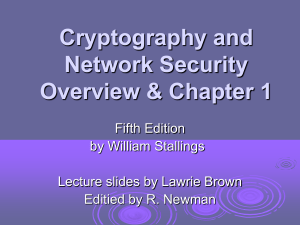
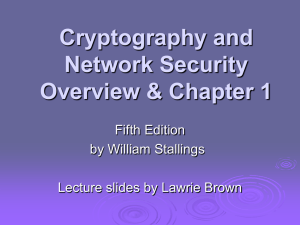
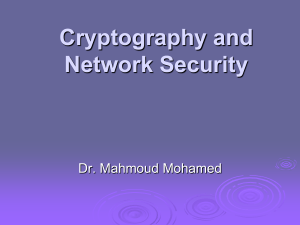
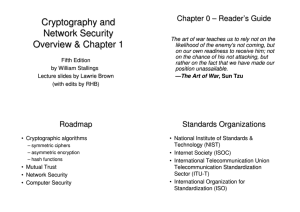

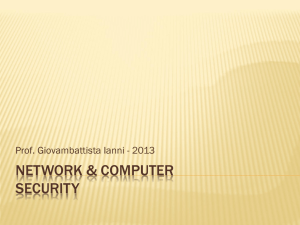

![Systems Assurance [Opens in New Window]](http://s3.studylib.net/store/data/007522633_2-e364c8f93e26286779d02c826b323ed6-300x300.png)
